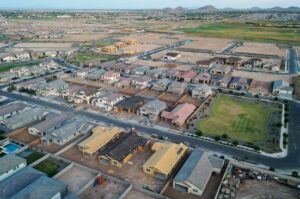A 50-year effort to position Phoenix as a cutting-edge city and center of innovation may finally be paying off. Recent investments in driverless cars, electric vehicles and computer chip manufacturing lend Arizona’s capital a “Jetsons”-like quality that appeals to tech titans, while its former military bases make ideal manufacturing sites, reports Axios. Now home to a $40 billion semiconductor plant, as well as the largest area in the world that is fully serviced by autonomous vehicles, Phoenix could well become the city of the future — if leaders can successfully address shortages of affordable housing and water.
By Alessandra Riemer, Editor at LinkedIn News
Phoenix is emerging as the city of the future

Phoenix is having a moment.
- Recent major investments in computer chip manufacturing and electric and autonomous vehicles have made it the overnight darling of the U.S. innovation elite.
Why it matters: The broad attention is showing the world what local leaders have spent the past half-century trying to prove: This desert city can be a major player in global tech and manufacturing.
State of play: Arizona has attracted more semiconductor investment since 2020 than any other U.S. state — driven mainly by Taiwan Semiconductor Manufacturing Co.’s $40 billion facilities in north Phoenix.
- Semiconductors are used in just about every electronic device — including electric and autonomous cars, fields in which Phoenix is also thriving.
Waymo has been testing its self-driving vehicles in metro Phoenix since 2017.
- It recently doubled its local ride-hailing service area to cover 180 square miles, the largest fully autonomous service area in the world.
- Five EV manufacturers have set up shop in Arizona since 2016, per the Arizona Commerce Authority.
How it happened: Government and business leaders pledged to diversify Phoenix’s construction-based economy after it collapsed during the 2008 housing crash.
- They formed the Arizona Commerce Authority, offered incentives and relaxed regulations to lure new companies.
Yes, but: Those moves were built on the back of decades of groundwork, strategic investments — and maybe some dumb luck too.
Flashback: Metro Phoenix was home to several U.S. Air Force and Navy training bases during World War II, which made it a natural fit for post-war military manufacturing.
- Motorola arrived in 1949, becoming the area’s first semiconductor facility.
- Intel followed, opening its first fabrication plant in the area in 1980.
- They attracted chemical suppliers, engineering outfits and other skilled manufacturing companies to metro Phoenix.
Meanwhile: The area has invited auto companies to test their products here for decades.
- General Motors, Goodyear, Ford, Chrysler and others established proving grounds on the outskirts of town in the 1940s and 1950s.
- Many still exist and are now used to test electric and autonomous vehicles.
What’s next: Homegrown innovation.
- Intel has been around long enough to see some of its engineers leave and start their own ventures. For example: Footprint, a Gilbert, Arizona-based company designing alternatives to plastic food packaging.
- Venture capitalists are finally taking the city’s startup scene seriously. In 2015, Arizona companies secured $396 million in VC money, per PitchBook. By 2018, that number had ballooned to $2.5 billion — though investments have slowed since.
Reality check: How far Phoenix’s national star rises depends on the city confronting some daunting challenges.
- It’s facing big city problems like housing affordability for the first time — plus the increasingly dire challenge of water security.
By Jessica Boehm, author of Axios Phoenix










